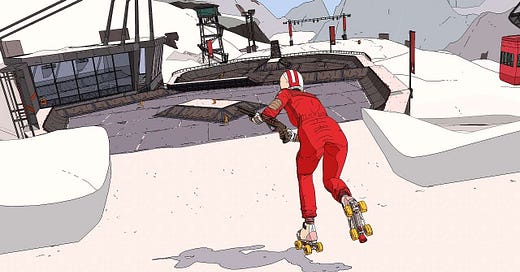Rollerdrome
Beneath the deceptive exterior of “Tony Hawk with guns” lies a powerfully eloquent examination of what happens when sport, commerce, and politics intertwine.
First Released: August 16th, 2022
Platforms: PS4, PS5, Xbox Series X/S, PC
Despite mostly positive reviews (a few of which were downright effusive), Rollerdrome seems to have become one of the most overlooked games of 2022. Perhaps it got crowded out when a flood of interesting indie titles like Neon White, Norco, and Immortality combined with the time-sucking behemoth that is Elden Ring. Or perhaps the game’s Tony Hawk's Pro Skater meets Max Payne premise seemed a bit insulting, like a cynical ploy to capture both halves of a weird marketing venn diagram.
Whatever the reason, it’s a crying shame this title has slipped into also-ran status because Rollerdrome is one of the most intelligent and moving titles I’ve ever come across. Though the game does offer straightforward videogame-ass-videogame action and simple bits of story, the way those two elements are combined creates something significantly deeper and richer than the experience implied by descriptions like “Tony Hawk with guns.” Though it may not look like it on the outside, Rollerdrome is a brilliant, insightful examination of what happens when sports, commerce, and politics intertwine—one that feels gong-ringingly, lightning-strikingly true.
The gameplay side of Rollerdrome is the Max Payne/Tony Hawk hybrid that the marketing promises. But what that marketing doesn’t tell you is that this action elicits, in a shockingly tangible way, the exhilaration and excitement of participating in a beloved spectator sport. The game’s mentally all-consuming action, when combined with the subtle bits of stadium ephemera (the rhythmically stomping crowd, the uncaring, echoey voice that intones your name when you complete a level, the visible presence of cameras and lights pointing at you), makes you feel like you are pushing your body to the limit in a professional arena. Many times, as the bright yellow “PASSED” screen appeared at the end of a level, I would reach my hand to my forehead to wipe away a bead of sweat only to realize my skin was dry. Rollerdrome’s action didn’t just get my heart pumping or tie my stomach in knots, it made me feel as if I was physically competing under the glare of a stadium spotlight.
This sense of physical exertion is then blended with extremely brief walking simulator-style narrative sections where you explore an environment set behind the scenes of the action, like a TV station’s green room or a train traveling from one event to the next. Not only are these areas themselves compact, every description you come across is radically short—all are no more than a few sentences in length, many are only a few words. And although at first it would seem like the game is just trying to get out of your way so you can go back to blasting away enemies, you gradually realize that this simplicity is actually a source of power. These sequences are brief because there is no fluff here, no filler. Each description is like a perfectly worded poem with no syllable wasted. Each area is a perfect life-size diorama with no corners or crevices where you could get lost, stuck, or bored.
The result of this conciseness is that these scenes gradually begin to cut like a scalpel. Every little detail—the line scratched through a name on a sheet of paper, an item hanging in a locker—conveys an immense amount of information in an intensely personal manner. Eventually these scenes start landing punches you never saw coming. A simple three word newspaper headline left me reeling, staring at the screen slack jawed for what felt like an eternity. Later, the entirety of the narrative’s progression is captured perfectly—I kid you not—in the description attached to a discarded soda can.
But it’s not just these narrative sections that make this game so compelling, it’s the way these narrative sections braid together with the gameplay to create something greater than the sum of their parts. The tale this game tells of a corporation buying up a sport in order to cleanse its image and distract from its politics is one that has a lot of real world parallels, but the conflict at the heart of those stories is rarely captured with the precision Rollerdrome offers. How better to explain the pure, unfiltered exhilaration of playing, or even simply watching a sport than to provide gameplay that conveys that rush? And how better to explore how that feeling is leveraged and corrupted by outside forces than to place you in rooms where the evidence of that corruption is all around you, impacting you, jabbing you with tiny, poetic knives? Rollerdrome swirls these together, this purity and this corruption, mixing their flavors, giving you that rare concoction that tastes unmistakably like the nuanced, complete reality we so rarely glimpse in our fractured, siloed, postmodern age.
Perhaps the best example of how this combination works can be found in the game’s concluding moment. As your body is still unwinding from the tension of beating the final level, you find yourself listening to an audio message from a character you’ve never met before. You are given a symbolic choice that corresponds to your reaction to what you’re hearing. Though the choices reflecting your reaction are binary, this moment provided me with that rare sensation where you experience every contradictory emotion at once: victory and defeat, joy and sorrow, happiness and anger, catharsis and the sting of a wound still open. It was a fleeting, perfect moment where I felt everything all at once.
I’m not sure that I can ask for anything more from any work of art.




